

How a Scene List Can Change Your Novel-Writing Life. How to Storyboard in Scrivener. Storyboarding as it pertains to novels and short stories is the process of mapping out your story, often using index cards, in a high-level way that allows you to see your story visually and rearrange it.
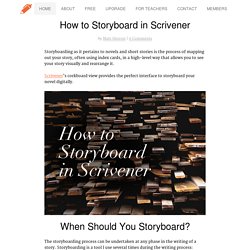
Scrivener’s corkboard view provides the perfect interface to storyboard your novel digitally. When Should You Storyboard? The storyboarding process can be undertaken at any phase in the writing of a story. Storyboarding is a tool I use several times during the writing process: before I begin writing (i.e. planning/plotting), during the rough draft (when I get stuck), and when I’m revising. It’s a way to see the big picture, make sure your story has good bones, and that everything logically flows from one scene to the next. To begin storyboarding, you must at least have an idea for a story. 50 Articles on Writing to Help You in 2015WritersDigest.com.
Over the past year I posted articles on this blog that covered everything—from grammar to writing better characters to getting published and more.

Here’s a cheat sheet linking to what I consider the 50 best articles that can help you reach your writing goals. Home Page. Main/MacGuffin. "In crook stories it is almost always the necklace, and in spy stories it is most always the papers.
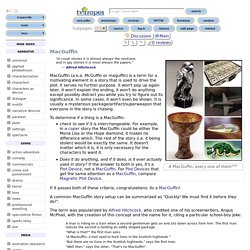
" MacGuffin (a.k.a. McGuffin or maguffin) is a term for a motivating element in a story that is used to drive the plot. It serves no further purpose. It won't pop up again later, it won't explain the ending, it won't do anything except possibly distract you while you try to figure out its significance. In some cases, it won't even be shown. A man is riding on a train when a second gentleman gets on and sits down across from him. Writing Dialect. Most people assume that dialect has to be a part of dialogue.

My answer is that it can be, and in certain circumstances it ought to be, but the writer must never feel compelled to duplicate dialects simply for the sake of “authenticity.” The writer who thinks she is writing dialect because she is clipping the ends off of words and stretching out others is often taking delight more in her own experimentation than in any real sense of story. She may be shooting for a folksy charm or for a root authenticity, but most often she fails miserably. Try all you want to make the words unrecognizable—misspell them, cut them in half, throw in a fistful of apostrophes, sound out every groan the character makes—but the truth is, they are still words you’re dealing with.
Consider this example. —By Tom Chiarella. How to Craft a Happy Ending. Our writing may be beautiful or plain, may want to sing itself along or proceed with the massive engine that is the great Russian truth-telling machine Anna Karenina.
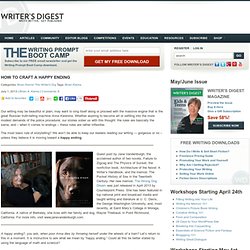
Whether aspiring to become art or settling into the more modest demands of the police procedural, our stories sober us with this thought: the rules are basically the same, and – when it comes to endings – these rules are rather inflexible. The most basic rule of storytelling? We won’t be able to keep our readers reading our writing — gorgeous or no – unless they believe it is moving toward a happy ending. Guest post by Jane Vandenburgh, the acclaimed author of two novels, Failure to Zigzag and The Physics of Sunset, the nonfiction book, Architecture of the Novel: A Writer’s Handbook, and the memoir, The Pocket History of Sex in the Twentieth Century.
Her new memoir, The Wrong Dog Dream was just released in April 2013 by Counterpoint Press. Your Novel Blueprint. A Simple Novel Outline – 9 questions for 25 chapters « H.E. Roulo. Just as every tree is different but still recognizably a tree, every story is different but contains elements that make it a story.

By defining those before you begin you clarify the scope of your work, identify your themes, and create the story you meant to write. At Norwescon 2011 I sat in on a session called Outline Your Novel in 90-minutes led by Mark Teppo. I’ll give you the brief, readable, synthesized version. Answer 9 questions and create 25 chapter titles and you’re there. Daily Writing Tips. Back story. How to Weave Backstory Into Your Novel Seamlessly Today's guest newsletter is from Karen Dionne, contributor to Writer's Digest.
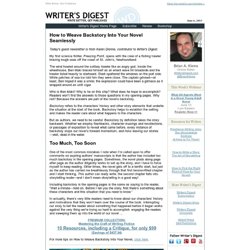
My first science thriller, Freezing Point , opens with the crew of a fishing trawler braving rough seas off the coast of St. John’s, Newfoundland: The wind howled around the solitary trawler like an angry god. Inside the wheelhouse, Ben Maki braced himself as an errant wave hit broadside and the trawler listed heavily to starboard. General Fiction. Getting Around...
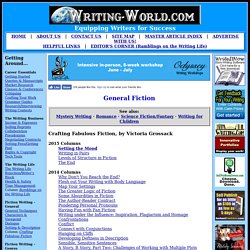
Career Essentials Getting Started Queries & Manuscripts Market Research Classes & Conferences Critiquing Crafting Your Work Grammar Guides Research/Interviewing Writing Contests The Writing Business Income & Expenses Selling Reprints Collaboration Pseudonyms Negotiating Contracts Setting Fees/Getting Paid Rights & Copyright Tech Tools. Are You Writing a Book With a Hook or a Gimmick?